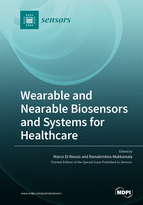Wearable and Nearable Biosensors and Systems for Healthcare
A special issue of Sensors (ISSN 1424-8220). This special issue belongs to the section "Biosensors".
Deadline for manuscript submissions: closed (31 October 2020) | Viewed by 61396
Special Issue Editors
Interests: textile sensors; smart garments; body sensor networks; 24-h and home cardiovascular monitoring; autonomic cardiac control; baroreflex modelling; seismocardiography; cardiac mechanics; hypertension; heart failure; space physiology, telemedicine, biosignal processing
Interests: cardiovascular system; computational physiology; medical devices; mHealth; patient monitoring; physiologic sensors; physiologic signal processing and identification; whole-animal, human, and patient studies
Special Issue Information
Dear Colleagues,
Biosensors and systems in the form of wearables and “nearables” (everyday sensorized objects with transmitting capabilities, e.g., smartphones) are rapidly evolving and used for the monitoring of health, exercise activity, and performance. Unlike conventional approaches, these devices enable convenient, continuous, and/or unobtrusive monitoring of a user’s vital signs during daily life. Examples of measurements include biopotentials, body motion, pressure, blood flow, temperature, and biochemical markers. These systems combine innovations in sensor design, electronics, data transmission, power management and signal processing. However, although much research has been carried out so far in this area, many technological aspects still remain to be optimized and represent open challenges for the scientific community.
This Special Issue invites original research papers and review articles aimed at proposing advancements in wearable and nearable biosensors and systems for healthcare. Exemplary topics of interest include biocompatible and stretchable materials, textile/flexible/tattoo/remote sensors and electronics, device miniaturization, low-power signal conditioning, multisensor wireless data transmission and synchronization, advanced algorithms for the analysis of sensor data, and extraction of biological features.
Prof. Marco Di Rienzo
Prof. Ramakrishna Mukkamala
Guest Editors
Manuscript Submission Information
Manuscripts should be submitted online at www.mdpi.com by registering and logging in to this website. Once you are registered, click here to go to the submission form. Manuscripts can be submitted until the deadline. All submissions that pass pre-check are peer-reviewed. Accepted papers will be published continuously in the journal (as soon as accepted) and will be listed together on the special issue website. Research articles, review articles as well as short communications are invited. For planned papers, a title and short abstract (about 100 words) can be sent to the Editorial Office for announcement on this website.
Submitted manuscripts should not have been published previously, nor be under consideration for publication elsewhere (except conference proceedings papers). All manuscripts are thoroughly refereed through a single-blind peer-review process. A guide for authors and other relevant information for submission of manuscripts is available on the Instructions for Authors page. Sensors is an international peer-reviewed open access semimonthly journal published by MDPI.
Please visit the Instructions for Authors page before submitting a manuscript. The Article Processing Charge (APC) for publication in this open access journal is 2600 CHF (Swiss Francs). Submitted papers should be well formatted and use good English. Authors may use MDPI's English editing service prior to publication or during author revisions.
Keywords
- Biosensors
- Low power systems
- Mobile devices
- Physiologic monitoring
- Sensor miniaturization
- Sensor signal processing
- Stretchable and flexible sensors and electronics
- Textile sensors
- Flexible and tattoo sensors and electronics
- Wearables
- Nearables
- Wireless data transmission








